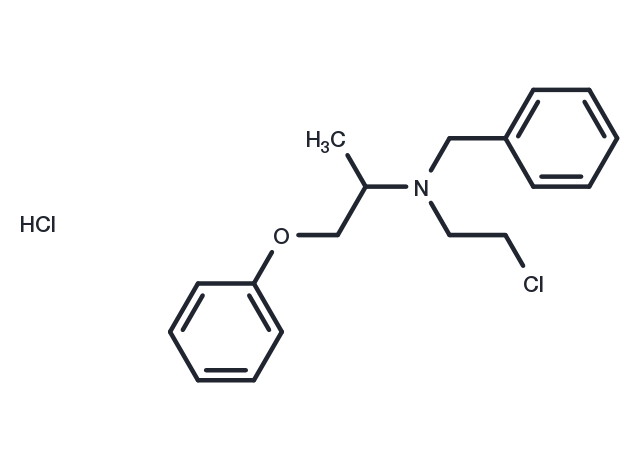Powder: -20°C for 3 years | In solvent: -80°C for 1 year
Phenoxybenzamine hydrochloride (NCI-c01661) is the hydrochloride salt form of phenoxybenzamine, a synthetic, dibenzamine alpha-adrenergic antagonist with antihypertensive and vasodilatory properties. Phenoxybenzamine non-selectively and irreversibly blocks the postsynaptic alpha-adrenergic receptor in smooth muscle, thereby preventing vasoconstriction, relieving vasospasms, and decreasing peripheral resistance. Reflex tachycardia may occur and may be enhanced by blockade of alpha-2 receptors which enhances norepinephrine release. Phenoxybenzamine is reasonably anticipated to be a human carcinogen.

| 説明 | Phenoxybenzamine hydrochloride (NCI-c01661) is the hydrochloride salt form of phenoxybenzamine, a synthetic, dibenzamine alpha-adrenergic antagonist with antihypertensive and vasodilatory properties. Phenoxybenzamine non-selectively and irreversibly blocks the postsynaptic alpha-adrenergic receptor in smooth muscle, thereby preventing vasoconstriction, relieving vasospasms, and decreasing peripheral resistance. Reflex tachycardia may occur and may be enhanced by blockade of alpha-2 receptors which enhances norepinephrine release. Phenoxybenzamine is reasonably anticipated to be a human carcinogen. |
| In vitro | The IC50 (100 nM) derived from the blockade of [3H]yohimbine binding by Phenoxybenzamine hydrochloride is significantly less than the IC50 (550 nM) for the corresponding reversal by Phenoxybenzamine hydrochloride of the effects of norepinephrine on cyclic AMP accumulation[1]. Phenoxybenzamine hydrochloride (50 nM) in conbination with Phenoxybenzamine hydrochloridetolamine (1000 nM) enhances Phenoxybenzamine hydrochlorideylephrine-induced contraction compared with pretreatment with Phenoxybenzamine hydrochloride (50 nM) alone in endothelium-intact aortae. Combined treatment with either dexmedetomidine (300 or 1000 nM) and Phenoxybenzamine hydrochloride (50 nM) or Phenoxybenzamine hydrochloridetolamine (1000 nM) and Phenoxybenzamine hydrochloride (50 nM) enhance Phenoxybenzamine hydrochlorideylephrine-induced contraction compared with Phenoxybenzamine hydrochloride alone (50 nM). In addition, combined treatment with Phenoxybenzamine hydrochloridetolamine and Phenoxybenzamine hydrochloride enhances Phenoxybenzamine hydrochlorideylephrine-induced contraction compared with dexmedetomidine (1000 nM) and Phenoxybenzamine hydrochloride combined treatment. Combined treatment with high concentrations of dexmedetomidine (1000 nM) and Phenoxybenzamine hydrochloride enhances Phenoxybenzamine hydrochlorideylephrine-induced contraction compared with combined treatment with low concentrations of dexmedetomidine (300 nM) and Phenoxybenzamine hydrochloride[2]. |
| In vivo | Phenoxybenzamine hydrochloride (20 nM, s.c.) effectively suppresses the tumorigenesis of glioma cells in mice and the cell density in Phenoxybenzamine hydrochloride-U87 mg xenografts decreases significantly[3]. Phenoxybenzamine hydrochloride (1 mg/kg, i.v.) treated rats shows significant improvements in NSS and foot fault scoring[4]. |
| 細胞研究 | Phenoxybenzamine hydrochloride is dissolved in DMSO. After cytometry, 1×3 cells are implanted in a 96-well plate in 100 μL DMEM supplemented with 10 % FBS. Ten microliter (10 % of the total volume) WST-1 (Water Soluble Tetrazolium) is added to cells and incubated at 37°C for 30 min before colorimetric assay with 450 nm excitation and 630 nm emission at 24 h intervals up to 96 h. The mean fluorescence value is counted, and the cell number is determined using the standard curve. |
| 別名 | NCI-c01661, NSC 37448, Phenoxybenzamine HCl |
| 分子量 | 340.3 |
| 分子式 | C18H23Cl2NO |
| CAS No. | 63-92-3 |
Powder: -20°C for 3 years | In solvent: -80°C for 1 year
Ethanol: 63 mg/mL (185.1 mM)
H2O: 14 mg/mL (41.1 mM)
DMSO: 63 mg/mL (185.1 mM)
You can also refer to dose conversion for different animals. 詳細
bottom
Please see Inhibitor Handling Instructions for more frequently ask questions. Topics include: how to prepare stock solutions, how to store products, and cautions on cell-based assays & animal experiments, etc.
Phenoxybenzamine hydrochloride 63-92-3 GPCR/G Protein Neuroscience Adrenergic Receptor CaMK pheochromocytoma Beta Receptor NCI-c01661 neuroprotective Phenoxybenzamine Hydrochloride NSC 37448 Inhibitor Phenoxybenzamine antitumor NSC37448 hypertension NSC-37448 inhibit Phenoxybenzamine HCl glioma inhibitor
